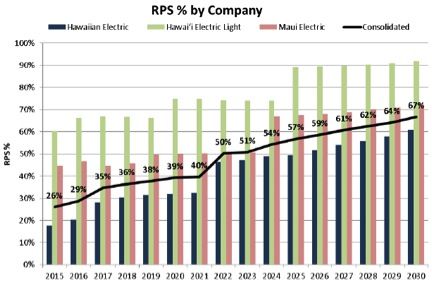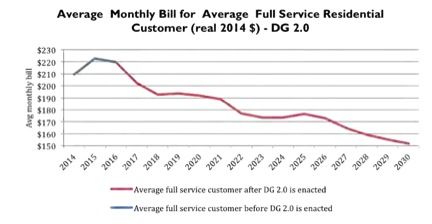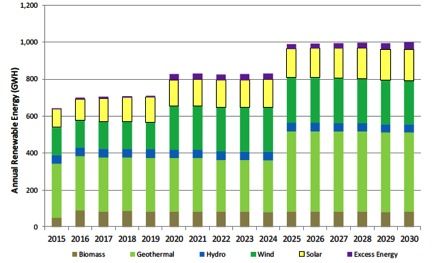Hawaii’s utilities just resubmitted long-term energy plans to the Hawaii Public Utilities Commission, and there was at least one very nice surprise: Hawaii Electric Light Company (HELCO), the utility that serves the Big Island, now plans to achieve 92 percent renewable electricity by 2030.
The Big Island of Hawaii has the potential to lead the country in its the transition from oil to renewables -- given its sky-high electric rates, its reliance on fossil fuels and its abundance of renewable resources. Hawaii’s people and its leaders recognized this many years ago and created a policy structure that might enable this major shift.
FIGURE 1: HELCO Projections for Renewable Electricity

Source: 2014 Power Supply Improvement Plan
Figure 2 shows the comparison between HELCO and the other utilities, with HELCO starting from a much higher point due to its geothermal power and wind power facilities already on-line (HELCO has two large wind power projects, one on each end of the island).
FIGURE 2: Comparing Hawaii’s Utilities

Source: 2014 Power Supply Improvement Plan
The fact that HELCO, under its own voluntary plans (with some urging from the PUC and the governor), projects a 92 percent renewable electricity level by 2030 is great news for the Big Island.
The best part of the new plan? It will save customers buckets of money. HELCO projects that average residential bills will fall, under the 92 percent renewables plan, by 27 percent from 2014 to 2030, and that’s without taking inflation into account.
FIGURE 3: HELCO Projections of Bill Costs Under the New Renewables Plan

Source: 2014 Power Supply Improvement Plan
So why not a 100 percent renewable standard?
This new plan is a compelling reason for making a 100 percent renewable energy commitment binding law. At the current juncture, these utility plans are projections of what is possible -- they’re not commitments by the utilities, nor are they mandates. However, since HELCO itself projects that it can cost-effectively reach 92 percent renewables by 2030, there is good reason to believe that a 100 percent renewable electricity mandate for the Big Island is within reach. And in order for it to be binding, this mandate should be codified in law by Hawaii’s legislature, or at the least codified in a PUC decision. (State laws are often created to codify mandates that have already been imposed by state PUCs, so this could be a route Hawaii might take.)
How do we get from 92 percent to 100 percent? Well, here’s the projected mix of power sources with which HELCO plans to achieve the 92 percent figure.
FIGURE 4: HELCO Planned Power Mix

Source: 2014 Power Supply Improvement Plan
The yellow bar representing solar in this chart is only for behind-the-meter solar. HELCO plans to triple installations of behind-the-meter solar, which is already at about 10 percent penetration, so this is a laudable goal. What the plan currently leaves out, however, other than a tiny sliver for 10 megawatts of feed-in tariff projects, is wholesale solar.
Just as wholesale wind and biomass can add cost-effective power to the grid, wholesale solar can provide reliable and cheap power to the grid. Solar power prices have plunged in recent years and it is increasingly cost-effective, even in states with moderate electricity prices.
Since the Power Supply Improvement Plan omits wholesale solar other than the currently authorized 10 megawatts of feed-in tariff projects, this oversight shows that reaching 100 percent renewables by 2030 could very likely be achievable.
I’ll get even more specific: HELCO’s very modest feed-in tariff program, currently stalled until further action by the PUC, could and should be expanded significantly. Prices should be revised and set at or below the avoided cost (the cost of power from diesel generators) and interconnection rules should be revised to ensure easy and safe access to the grid. By setting prices at or below the avoided cost, HELCO can ensure that customers will still save money while also obtaining more solar power.
What about grid reliability at 100 percent renewables?
HELCO plans to keep some fossil fuel plants on-line to act as grid stabilizers, but it also plans to add significant amounts of energy storage to the grid by 2030. Energy storage can provide all of the benefits that diesel or LNG power plants provide, but it is still a fairly nascent technology. Costs are also uncertain at this time for energy storage, but we can be assured that costs will come down rapidly as production ramps up around the world, similar to the recent history of solar and wind power technologies.
While we shouldn’t flippantly assert that energy storage can provide all necessary grid stability for the Big Island by 2030, we can state with some confidence that a mix of energy storage, baseload biomass, baseload geothermal (on the Kona side of the island in particular, as discussed below), and some residual fossil-fuel plants for occasional backup, can and should provide the grid stability required for the Big Island.
HELCO is being prudent in its new plan in calling for some remaining fossil-fuel capacity, even in 2030. But my view is that we won’t need that capacity for anything but occasional backup, and eventually, not even for that. If HELCO pushes for 100 percent renewables rather than “only” 92 percent, it can still use fossil-fuel backup power if necessary, but for all intents and purposes, the island would be fully powered by renewables.
Having a 100 percent RPS doesn’t mean fossil fuel power is outlawed. Rather, it means that on a net basis, all or very nearly all of the power on island is produced from renewable sources
What about geothermal?
While I strongly support geothermal power in most locations around the U.S. where it can be developed cost-effectively, the Big Island is a really bad place for geothermal, particularly at its current location in Puna near the Pohoiki boat ramp.
I live, part-time, not too far from this plant, the only geothermal plant currently operating on the Big Island, and I know many others who live nearby too. The plant, known as Puna Geothermal Venture (PGV) and owned by Ormat Technologies, an Israeli company, has on many occasions belched noxious gases into the air around the plant. The most dangerous release occurred in 1991, and a major report was completed in 1992 to determine how this happened. Many releases have occurred since, including a large one induced by the remnants of Hurricane Iselle that hit the island on August 7. Amazingly, it's only very recently that a significant study has been initiated to investigate the health effects of PGV. This study is set to start next year and may take three years to complete.
The gases that PGV emits are natural in that they come from the natural processes that lead to the lava flows and volcanoes that are one of the more remarkable features of living on the Big Island. However, these releases wouldn’t happen where and when they have if PGV wasn’t operating. PGV is located very close to the homes of several thousand residents. In contrast, the natural outgassing from Kilauea and Pu’u O’o are miles downwind and rarely affect these communities.
Also, since PGV is the only geothermal plant currently operating on the Big Island, it raises difficult questions about reliability and security. What if an earthquake knocked the plant offline temporarily or permanently? If PGV is expanded from its current 35 megawatts, this vulnerability is further increased. If additional geothermal plants are added in the Puna area, a single volcanic or earthquake event could take all of the plants offline.
The fact that a new lava flow is heading in the general direction of PGV isn’t encouraging for the future of geothermal on the Big Island. While the current lava flow is headed for the town of Pahoa and not directly toward PGV, it highlights the very real possibility of major destruction being caused by the active volcanoes in the area, as with the destruction of the nearby towns of Kapoho in 1960 and Kalapana in 1986. Lava and volcanoes are real threats on the Big Island, and PGV is located close to the very rift zone that is considered to be the most hazardous volcanic area on the island (Lava Risk Zone 1).
So, geothermal isn’t a very good idea for the Big Island -- at least not in the highly volatile Puna region. HELCO’s new plan calls for 25 megawatts of new geothermal to be added on the Kona side of the island, which would reduce lava risk substantially, and probably reduce earthquake risks too. It remains to be seen, however, if a plant on the Kona side can be built cost-effectively.
A major benefit of wind and solar is not only that it is highly cost-effective already, but that it can also be distributed widely around the island. Lava flows can of course take out wind turbines and solar panels as well as geothermal plants, but the modular nature of solar and wind means that only the components actually destroyed are taken out, and the rest of the project components can stay on-line if the power lines are kept intact. And if these technologies are widely distributed around the island, as is already the case for solar, the risk of any major disruption from earthquakes or lava is strongly mitigated.
Right now, HELCO is scrambling to ensure that power supplies for the Puna region will remain operational if the current lava flow, known as the June 27 flow, takes out any power lines. If this does happen, many thousands of people who live in lower Puna could be left without power. It may also cut off PGV from the rest of the grid. The risks I’m talking about here are not abstract.
In sum, the current lava flow is serious but will eventually stop and the community will recover, as will HELCO’s grid. It’s a cautionary tale, but it is far from being a major roadblock to getting the Big Island off fossil fuels. Instead, it’s actually a major boost for these efforts, because it highlights the benefits of distributed renewables. A combination of wind, solar, biomass, energy storage and some residual diesel or liquefied natural gas power plants can and should supply 100 percent of the power on the Big Island. For these reasons, I urge policymakers to strongly consider a new bill that would codify a 100 percent RPS for the Big Island and allow this thriving community to show the world how to wean itself from fossil fuels in a cost-effective way.
***
Tam Hunt is owner of Community Renewable Solutions LLC, a renewable energy project development and policy advocacy firm based in Santa Barbara, California and Hilo, Hawaii.



